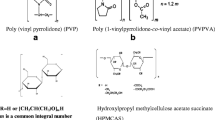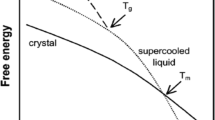Abstract
Purpose. To explore using thermally stimulated depolarization current (TSDC), in comparison to differential scanning calorimetry (DSC), for the characterization of molecular mobility of an amorphous pharmaceutical new chemical entity (LAB687), an amorphous polymer (PVPK-30), and their combination as solid dispersions at different % drug loadings.
Methods. Amorphous drug was prepared by quenching from the melt. Solid dispersions containing 10-60% of drug in polymer were prepared by solvent evaporation method. Glass transition temperatures (Tg) were determined by DSC and TSDC.
Results. In comparison to a single Tg obtained from DSC for the drug substance, TSDC shows two overlapping relaxations. Both peaks correspond to α-relaxations that are associated with the glass transition, with the second peak corresponding to the rigid fraction that is difficult to be detected by DSC because it is associated with only small changes in heat capacity. Two overlapping relaxations were also observed for the polymer vs. one Tg by DSC. The lower temperature relaxation is believed to be a β-relaxation, whereas the higher temperature transition corresponds to an α-relaxation. For the solid dispersions, one single peak was obtained for each of the 20% and 30% dispersions in excellent agreement with the DSC results. However, at the 40% drug load, a small shoulder was observed by TSDC at the low temperature of the main peak. This shoulder becomes more pronounced and overlaps with the main peak as the drug load increases to 50% and 60%. Agreement between the Tg values calculated by the Gordon-Taylor equation and the DSC and TSDC experimental data, especially for the 20% and 30% drug loading, indicate ideal miscibility. At higher drug loads, only by TSDC was it possible to detect the saturation level of the drug in the polymer.
Conclusions. TSDC proved to be very sensitive in detecting small reorientational motions in solids and in separating overlapping events with only slight differences in molecular motion exhibited as broad events in DSC. This allowed for detection of the rigid fraction of the amorphous drug, the sub-glass transition β- relaxation in the polymer, and the limit of miscibility between the drug and the polymer in the solid dispersions.
Similar content being viewed by others
REFERENCES
B. C. Hancock and G. Zografi. Characteristics and significance of the amorphous state in pharmaceutical systems. J. Pharm. Sci. 86:1–12 (1997).
V. Andronis and G. Zografi. Crystal nucleation and growth of indomethacin polymorphs from the amorphous state. J. Non-Cryst. Solids. 270:236–248 (2000).
S. L. Shamblin, X. Tang, L. Chang, B. C. Hancock, and M. J. Pikal. Characterization of the time scales of molecular motion in pharmaceutically important glasses. J. Phys. Chem. B 103:4113–4121 (1999).
M. Zielinski and M. Kryszewski. Thermal sampling technique for the thermally stimulated discharge in polymers. Phys. Stat. Sol. 42:305–314 (1977).
N. T. Correia, C. Alvarez, J. J. Moura Ramos, and M. Descamps. The β-α-branching in d-sorbitol as studied by thermally stimu-lated depolarization currents (TSDS). J. Phys. Chem. B 105:5663–5669 (2001).
TSC/RMA 9000 Instrument Manual. Ther Mold Partners, Stamford, CT.
R. A. Shmeis, Z. Wang, and S. L. Krill. A mechanistic investigation of an amorphous pharmaceutical and its solid dispersions, part II: molecular mobility and activation thermodynamic parameters. Pharm. Res. 21:2031–2039 (2004).
J. Li, Y. Guo, and G. Zografi. The solid-state stability of amor-phous Quinapril in the presence of β-cyclodextrins. J. Pharm. Sci. 91(1):229–243 (2002).
Author information
Authors and Affiliations
Rights and permissions
About this article
Cite this article
Shmeis, R.A., Wang, Z. & Krill, S.L. A Mechanistic Investigation of an Amorphous Pharmaceutical and Its Solid Dispersions, Part I: A Comparative Analysis by Thermally Stimulated Depolarization Current and Differential Scanning Calorimetry. Pharm Res 21, 2025–2030 (2004). https://doi.org/10.1023/B:PHAM.0000048193.94922.09
Issue Date:
DOI: https://doi.org/10.1023/B:PHAM.0000048193.94922.09




